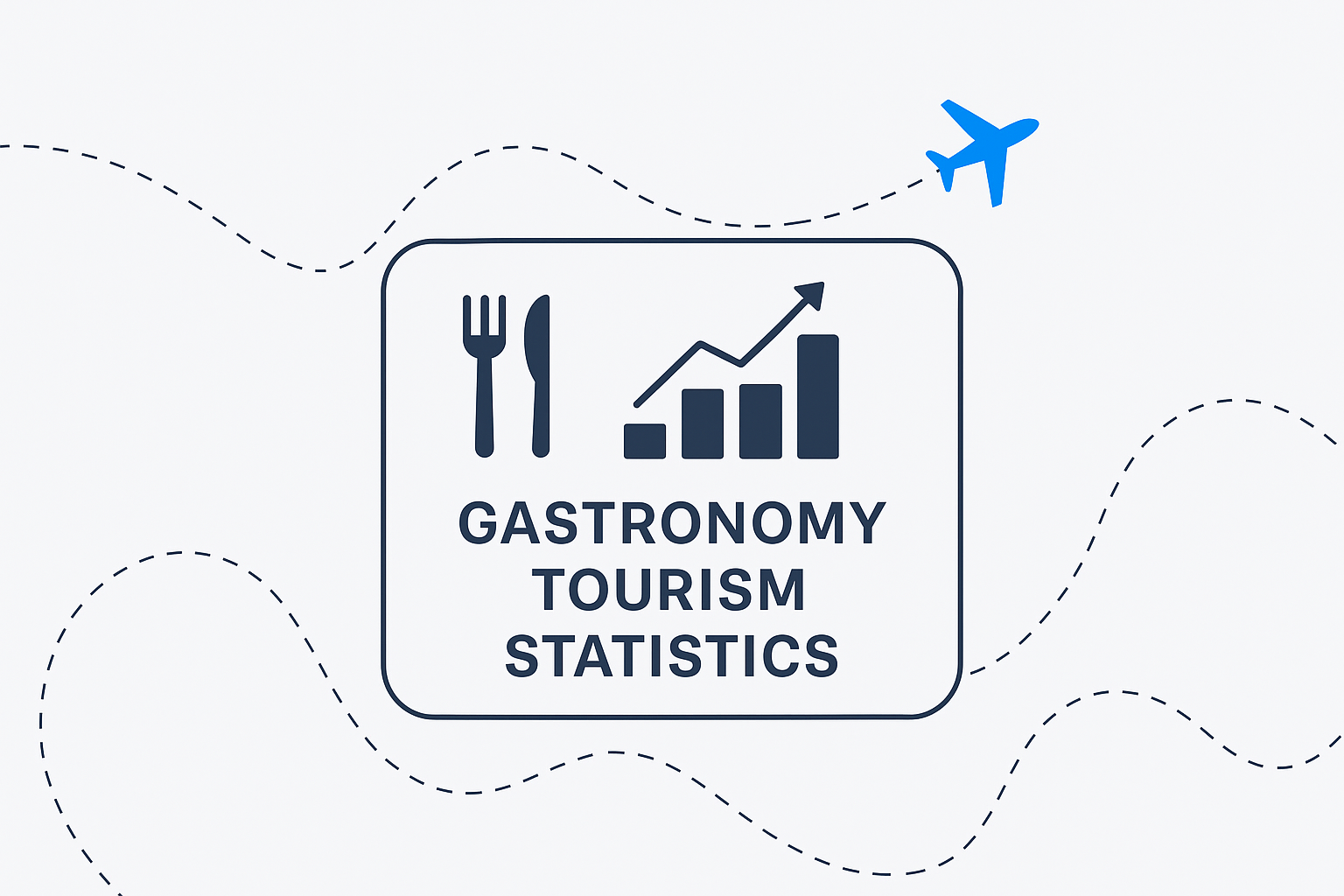Gastronomy tourism—also called culinary tourism—is no longer niche. Travelers are planning trips around food, from market tours and tasting menus to regional food festivals.
The market was worth $11.5 billion in 2023 and is on pace to hit $40.5 billion by 2030. That’s fast growth and a clear sign that food is now a main reason to travel, not just a nice extra.
The behavior backs it up: more than half of leisure travelers consider themselves “food travelers,” and most say they learn about local food and drink when they visit a new place. Pair that with a strong global travel rebound, and it’s easy to see why culinary experiences are booming.
This guide rounds up the latest gastronomy tourism statistics for 2025—market size, who these travelers are, what they spend, where the action is, and what’s coming next.
What Are the Key Gastronomy Tourism Statistics in 2025?
- Market size & growth: $11.5B (2023) → $13.6B (2024) → $40.5B (2030); roughly ~19.9% CAGR.
- Regional scale: North America revenue at $3.04B (2023) with ~19.1% CAGR projected to 2030.
- U.S. snapshot: About $2.70B (2024) with ~19.2% CAGR expected (2025–2030).
- Traveler behavior: 53% of leisure travelers identify as “food travelers”; 81% learn about food & drink on trips.
- Budget share: Visitors spend ~25% of trip budgets on food & beverage on average (up to ~35% in costlier destinations).
- Activities: Food festivals were the largest revenue segment in 2023; culinary trails are the fastest-growing.
How Fast Is Culinary Tourism Growing Worldwide?
Short answer: very fast. Analysts show steady double-digit growth through the decade as more destinations build culinary calendars and themed trails.
Global Market Growth (Culinary/Gastronomy Tourism)
| Year | Market Value (USD) |
|---|---|
| 2023 | 11.5 billion |
| 2024 | 13.58 billion |
| 2030 (proj.) | 40.53 billion |
Who Are Gastronomy Travelers and What Motivates Them?
Food travelers aren’t a niche club—they’re mainstream. 53% of leisure travelers fit the profile, and 81% say they actively learn about local food and drink. Why they go: to taste the place, join a festival, or follow a curated route that strings together producers, restaurants, and experiences.
Behavior & Motivation Snapshot
| Metric | Latest Reading | Notes |
|---|---|---|
| Leisure travelers who are “food travelers” | 53% | Broad appeal across age groups |
| Travelers who learn about F&B on trips | 81% | Food as culture driver |
| Largest 2023 activity by revenue | Food festivals | Anchor events for peak seasons |
| Fastest-growing activity | Culinary trails | Easy-to-follow, high-yield itineraries |
How Much Do Visitors Spend on Food and Drink?
Food and drink take a big slice of the travel wallet. On average, visitors spend about a quarter of their trip budget on F&B—and in high-cost destinations, that can push toward a third.
For destinations and operators, that means tastings, chef’s tables, market tours, and pairing menus aren’t just nice to have—they’re core revenue drivers.
Which Regions and Activities Lead Gastronomy Tourism?
North America posted $3.04B in culinary tourism revenue in 2023, with a strong growth runway ahead.
Globally, food festivals lead the revenue table, while culinary trails are the breakout format, encouraging longer stays and repeat visits. The U.S. market alone reached $2.70B in 2024.
Regional & Activity Snapshot
| Item | Latest Value | Detail |
|---|---|---|
| North America (market revenue) | $3.04B (2023) | ~19.1% CAGR to 2030 |
| U.S. market size | $2.70B (2024) | ~19.2% CAGR (2025–2030) |
| Food festivals (global activity revenue) | $3.62B (2023) | Largest activity |
| Fastest-growing activity | Culinary trails | Poised for fastest growth |
What Trends Will Shape Gastronomy Tourism Next?
- Festival-forward calendars: Signature food festivals anchor demand and help spread visitors across regions and seasons.
- Trailification: Culinary trails make it simple to book multi-stop itineraries—great for storytelling and spend.
- Recovery tailwinds: With international travel back in force, destinations are using food to add depth, extend stays, and lift per-trip spending.
FAQ About Gastronomy Tourism
How big is the culinary/gastronomy tourism market?
About $11.5B (2023), on track for $40.5B by 2030.
How fast is it growing?
Roughly ~19–20% CAGR through 2030, according to multiple market summaries.
What share of a traveler’s budget goes to food & beverage?
On average ~25%, rising to ~35% in higher-cost destinations.
How many travelers are “food travelers”?
About 53% of leisure travelers; 81% engage with food and drink learning on trips.
Which activities are biggest or fastest-growing?
Food festivals are currently the biggest by revenue; culinary trails are growing the fastest.
Sources
- Grand View Research — Culinary Tourism Market Size, Share & Growth (FAQ & Overview)
- Grand View Research — Global Culinary Tourism Market Outlook
- Grand View Research — Culinary Tourism Market to Reach USD 40.53B by 2030
- Grand View Research — North America Culinary Tourism Market Highlights
- Grand View Research — U.S. Culinary Tourism Market Size & Forecast
- World Food Travel Association (via review) — Behavioral Intentions of Food Tourists (WFTA indicators)
- UN Tourism — Tourism Recovery Updates (2024–2025)
- UN Tourism — World Tourism Barometer (Dec 2024)
- WTTC — Economic Impact Research 2024 (Global)
- Grand View Research (FAQ note) — Share of Trip Budget on Food & Beverage



0 Comment